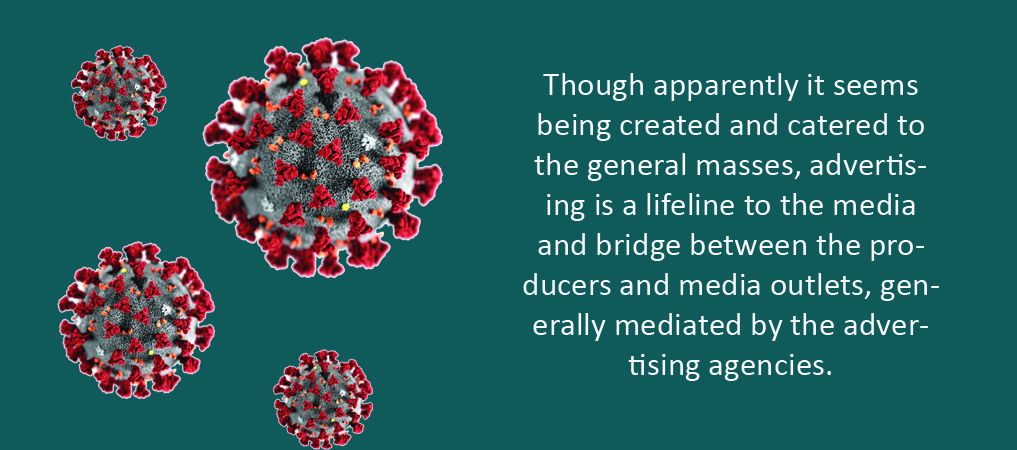Advertising industry loses Rs. 6 billion to COVID-19 pandemic

By Modnath Dhakal
Kathmandu, July 26: The coronavirus pandemic and subsequent lockdown has severely hit the advertising business in the country with estimated losses of about Rs. 6 billion.
According to the Advertising Association of Nepal (AAN) total value of advertising market in the country, including the mass media and signage, has crossed Rs. 12 billion.
“The industry has lost about half of its total annual revenue due to the pandemic. The four-month lockdown has affected as much as 80 per cent of the total advertising business,” said Rabindra Kumar Rijal, President of AAN.
He said that advertising spending from the private sector as well as government agencies went down drastically and the trend was likely to continue until Dashain, the major festival in the country.
The advertising business tumbled as low as 20 per cent during the initial months of lockdown, said Santosh Shrestha, immediate past president of AAN.
The government imposed nationwide lockdown on 24 March and lifted it from 22 July.
Though apparently it seems being created and catered to the general masses, advertising is a lifeline to the media and bridge between the producers and media outlets, generally mediated by the advertising agencies.
As the lockdown forced majority of the industries and businesses to shut down for an indefinite period, the producers pulled off most of the promotion campaigns and advertising, said Shambhu Adhikari, Chief Executive Officer of Cosmos Advertising Agency.
Advertising budget was the first thing to cut when the companies applied austerity measures during the pandemic. Even the businesses like banks and financial institutions, and insurance companies significantly lowered their advertising and promotional campaigns.
Meanwhile, the pandemic wreaked havoc on mass media channels, newspapers and magazines couldn’t be distributed and some continued only with their digital version of the publication while television reporting and programme diversity was significantly affected due to the difficulties in mobility and threat of infection.
Mainstream media lost about 90 per cent of the advertisement. Large publication houses have announced the closure of their magazines and laid off journalists en-masse. Two broadsheet dailies from Kathmandu and hundreds from the districts are still off print.
Advertising industry insiders say that the print media was almost bare in terms of advertisement while many television channels continued playing the commercials free of cost as they had to fill the time which had grown larger because of the constraints in production.
Job loss
Lack of business caused the job losses of many advertising professionals including the creative writers and directors. Shrestha said that although there was no specific data, a significant number of advertising professionals and support staff have lost their jobs temporarily or permanently. He also said that the looming fear of job loss or salary cut has affected the creativity as well.
The largest source of advertising during the lockdown was the government welfare advertising. However, most of it was directly sent to the media by the government and the ad agencies were least benefitted by it. Only a negligible number of private sector businesses created welfare advertising or Public Service Announcement, and most of it was dealt directly with the media, said Adhikari.
Coronavirus has taken a heavy toll on the signage business, another important component of advertising. Most of the jobs in the sector were affected. Signage business has Rs. 7 billion investment, 3,500 entrepreneurs and 75,000 jobs.
Rijal said that 10-15 per cent jobs might be lost permanently. “We have been paying 50 per cent salary to the staff even for the lockdown period,” he said.
New Year missed
Producers of cement and iron bars were the largest advertisers in terms of the amount spent before
the advent of the coronavirus pandemic. “Since most of the small infrastructure projects and individual construction was affected due to the lockdown, the producers pulled off most of the advertising,” said Adhikari.
Likewise, the disturbance in the supply chain of products other than the food items and essential goods had shrunk their market and the producers cancelled their planned advertising campaigns and did not renew the contract with the media. Commercials of the FMCG (fast moving consumer goods) products were also reduced drastically.
Advertising business witnessed the largest losses as it missed the mega season during the Nepali New Year which is the biggest opportunity for advertisers, ad agencies, media and consumers equally as many producers and
distributors announce discount on the price of goods and services and offer prizes.
The New Year and fiscal year close period were the two major business opportunities that they and the media channels missed during the lockdown.
Digital growth
The COVID-19 crisis has, however, created an opportunity for digital advertising. The access to internet and digital platforms as well as public’s hunger to get the updates at the earliest has increased the popularity of the digital media, said Adhikari.
He said that many audiences of print media and television were gradually shifting to the digital one.
Shrestha also said that the digital trend in Nepal was started about a decade ago but the coronavirus had given a significant push to its growth and development. “Now the advertisers plan their campaign with mobile phone at the centre.”
Recent News

Do not make expressions casting dout on election: EC
14 Apr, 2022
CM Bhatta says may New Year 2079 BS inspire positive thinking
14 Apr, 2022
Three new cases, 44 recoveries in 24 hours
14 Apr, 2022
689 climbers of 84 teams so far acquire permits for climbing various peaks this spring season
14 Apr, 2022
How the rising cost of living crisis is impacting Nepal
14 Apr, 2022
US military confirms an interstellar meteor collided with Earth
14 Apr, 2022
Valneva Covid vaccine approved for use in UK
14 Apr, 2022
Chair Prachanda highlights need of unity among Maoist, Communist forces
14 Apr, 2022
Ranbir Kapoor and Alia Bhatt: Bollywood toasts star couple on wedding
14 Apr, 2022
President Bhandari confers decorations (Photo Feature)
14 Apr, 2022











